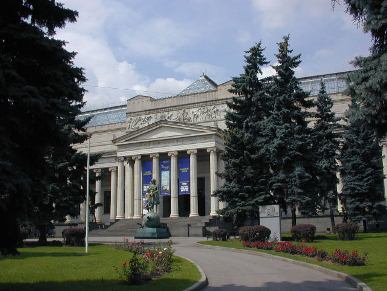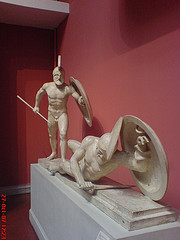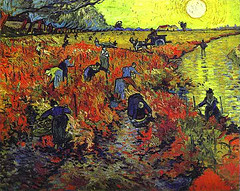

Ulitsa Volkhonka 12
Tel. (495) 697 9578
Subway: Kropotkinskaya
Open: 10am- 7pm Tue- Sun


The Pushkin state Museum of fine arts is the largest Museum
of European art in Moscow, located on Volkhonka street, opposite
the Cathedral of Christ the Saviour. Since 1981, the Pushkin
Museum has hosted the Svyatoslav Richter international music
festival.
The Museum's current name is somewhat
misleading, as it has no direct links to the famous Russian poet
Alexander Pushkin, except as a posthumous commemoration of his
name and fame. The object was founded by Professor Ivan Tsvetaev
(father of the poet Marina Tsvetaeva). Tsvetaev convinced the
millionaire and philanthropist Yuri Nechaev-Maltsov and the
fashionable architect Roman Klein of the urgent need to provide
Moscow with a Museum of fine arts. After undergoing several
changes, especially during the transition to the Soviet era and
the return of the Russian capital to Moscow, the Museum was
finally renamed in honor of Pushkin's memory in 1937, on the
100th anniversary of his death.
The building of the
Pushkin State Museum of fine arts was designed by architects
Roman Klein and Vladimir Shukhov and financed mainly by Yuri
Nechaev-Maltsov. Construction work began in 1898 and continued
until 1912. Ivan Rerberg led structural engineering work on the
Museum's territory for 12 years, until 1909.
In 2008,
President Dmitry Medvedev announced plans for restoration, which
cost about $ 177 million. 22 billion expansion RUB (670 million)
Designed by Norman foster in collaboration with local
architectural firm Mosproekt-5, it was confirmed in 2009, but
has been mired in disputes with officials and advocates.
Concerns grew that it would not be completed on schedule for
2018 After Moscow's chief architect, Sergei Kuznetsov, gave an
ultimatum demanding that foster take a more active role in the
project and confirmed his commitment by arriving in the Russian
capital within a month. Norman foster's firm abandoned the
project in 2013. In 2014, Russian architect Yuri Grigoryan and
his firm "Project Meganom" were selected to implement the
project. The renovation will preserve the historic 1930s gas
station near the main Pushkin building inside a glass structure.
The accumulated treasures of the Pushkin Museum of
fine arts reflect the tastes of many private collectors whose
holdings were nationalized by the Soviet government after the
revolution. The most important of them were two outstanding experts:
Sergey Shchukin and Ivan Morozov. By 1914, Shchukin had acquired
more than 220 paintings by French artists, including many works by
Cezanne. More importantly, Shchukin supported Matisse and Picasso
when they were still relatively unknown. Morozov also collected
paintings by these two artists, along with paintings by Renoir, van
Gogh and Gauguin.
Art collection
The Museum's art
collection includes more than 350,000 works, including works by
Durer, Andrea Mantegna, Claude Callot, Rembrandt, Anton Zubov, Karl
Bryullov, Ilya Repin, Dmitry Vrubel, Anna Ostroumova-Lebedeva and
Nivinsky.
The exhibition is arranged in chronological order
and begins with the art of the I-XIV centuries. The Museum exhibits
Fayum portraits - examples of easel painting, painted on boards in
the burials of the Fayum oasis of the I-IV centuries. There is also
a fragment of a mosaic depicting St. Joseph from the beginning of
the XVIII century-part of the composition "the Nativity of Christ"
from the Basilica of St. Peter's Basilica in the Vatican. The
collection also includes 14th-century Byzantine icons Dating back to
the Palaiologos dynasty: "The twelve apostles", "the virgin with the
infant Christ", "Annunciation" and "assumption of the virgin", "St.
Panteleimon".
The Pushkin Museum also displays Italian art
from the 13th-15th centuries, including the 13th-century
hagiographic icon "Madonna and child on a throne" by artists from
Naples, Pistoia, Florence and Siena, as well as triptychs. A
separate exhibition is dedicated to European art of the XV-XVI
centuries by artists from Italy, the Netherlands and Germany.
Examples of the Spanish Renaissance are the paintings of the Spanish
figure Pedro Esparagez "Archangel Michael weighing the souls of the
dead"," Madonna and child "by Perugino, Guidoccio di Giovanni
Cozzarelli" the Baptism of Christ " and others. The Museum has a
collection of majolica of the XVI century: a dish depicting the
entrance of Christ to Jerusalem, Venetian Albarella, a dish with the
coat of arms of the city of Deruta, a plate with Neptune.
The
collection also includes Flemish and Spanish art of the XVI-XVII
centuries: paintings by Pieter Bruegel the Younger, Joos de Momper,
Lucas van Euden, Rubens, Jacob Jordans, Antonis van Dyck, Frans
sneijders, Jan Feit, Siberhets, Rembrandt and others. Italian art of
the XVII—XVIII centuries is represented by works by Caravaggio,
Agostino Carracci, Guido Reni, Domenico fetti, Johann Liss, Strozzi
and others.
Art of ancient civilizations
The Museum's
archaeological exhibits relate to both ancient Mesopotamia and the
empires of the New World. Among them is a fascinating collection
presented by the Egyptologist Vladimir Golenishchev in 1913. The
exhibition features famous portraits of tombs from Fayum and two
exquisite black figures of the high priest Amen-Hotep and his wife,
the priestess Re-Nai. There is also an assortment of items from
ancient Greece and Rome, including a fine collection of Greek vases
in black figure and red pattern. The fabulous treasure of Troy show
featuring Golden artefacts unearthed from the legendary city in the
1870s is now open to the public.
The collection of ancient
Egyptian exhibits includes about 800 items Dating from the IV
century BC to the IV century. The exhibition is arranged in
chronological order. The collection includes wooden and stone
sarcophagi, reliefs, sculptures, ornaments, papyri, vessels,
figurines and amulets. The most valuable exhibits are stone tools of
the VI—V Millennium BC, slate pallets and painted vessels of the
Negada cultures of the I-III centuries BC. Funeral rites that played
an important role in the religious life of the Egyptians are
presented separately. The collection also includes sarcophagi,
canopies, funerary masks, ushebti figurines, statuettes of gods and
the mummy of the priest Horch, on which a net of faience beads was
found during excavations.
European art of the 13th-16th
centuries.
The Pushkin Museum of fine arts contains a small but
memorable collection of medieval and Renaissance art. It includes a
series of altar panels painted by Italian artists in the Byzantine
tradition. Siena was a major art center in the 14th century, and
Simone Martini was a leading master at the Siena school. Among the
exhibits are his naturalistic images of Saint Augustine and Mary
Magdalene, painted in the 1320s. The exhibit also features some of
the later religious works, including a triptych by Pietro di
Giovanni Leonori. There are also two outstanding old works written
in the 1490s: the excellent Annunciation by Sandro Botticelli, and
the Madonna and child by Pietro Perugino. The Museum does not have a
large collection of German and Flemish masters of the time. However,
two notable exceptions are Pieter Bruegel the Younger's "Winter
landscape with a bird trap" and Lucas Cranach the Elder's "the
virgin and child". The painting is drawn on a tree and places the
virgin and child in the context of a typical German landscape.
European art of the 17th and 18th centuries
At the Museum of fine
arts named after A. S. Pushkin has an enviable collection of Dutch
and Flemish masters of the 17th century. It includes Anthony van
Dyck's completed portraits of the wealthy burgher Adrian Stevens and
his wife Maria Beauchaert, painted in 1629, and some anticipatory
landscapes by Jan van Goyen and Jacob van Ruysael. Also on display
are still lifes by Frans Snyders, some delightful genre scenes by
Jan Stiva, Pieter de Hoch and Gabriel Metsu, and several works by
Peter Paul Rubens, including the characteristically vivid and
sensual Bacchanal (c. 1615). The gallery displays six masterful
paintings by Rembrandt, as well as some of his drawings and
engravings. Paintings include the biblical characters Artaxerus,
Haman and Esther (1660)," Christ drives the money changers out of
the temple "(1626), and" the old Woman", a sensitive portrait of the
artist's mother (1654).
The gallery has a modest collection
of Spanish and Italian paintings from the 17th and 18th centuries.
Spanish artists include Bartolome Esteban Murillo, known for his
religious scenes and portraits. Works displayed by Italian artists
include the betrothal of the Doges and the sea (1729-30) by
Canaletto, widely considered a master of the urban landscape style
known as Veduta. The Pushkin Museum is rightly known for its
collection of French art, which includes paintings of classical and
epic subjects by various artists. Among the paintings on display are
Nicolas Poussin's drama " The battle of the Israelites with the
Amorites "(c.1625) and Francois Boucher's" Hercules and Omphale "
(1730s). The latter depicts the myth of Hercules-Hercules, who was
sold as a slave to Queen Omphale.
European art of the XIX century
At the
beginning of the XIX century, classicism in art gradually gave way
to romanticism. This shift resulted in works such as After the
shipwreck (1847) by Eugene Delacroix, which portrays the sea as a
force of nature, unpredictable and hostile to man. Also on display
are works by other artists of the period, such as landscape painters
like John constable and Caspar David Friedrich. The Pushkin Museum
of fine arts has a fine collection of paintings by artists of the
French Barbizon school, who were the forerunners of the
Impressionists. These include landscapes by Camille Corot, Francois
millet, and Gustave Courbet.
Temporary exhibitions feature
paintings from a huge collection of works by the Impressionists
themselves. Visitors can see paintings by artists such as Edouard
Manet, Edgar Degas, Pierre Auguste Renoir and Claude Monet. The
Pushkin Museum of fine arts has eleven paintings by Monet, including
lilac in the sun (1873) and two of a series of 20 paintings of the
Rouen Cathedral. There are also fine Renoir paintings, including
Nudes and a glowing Portrait of the Actress Jeanne Samari (1877).
Along with landscapes and street scenes by Alfred Sisley and Camilla
Pizarro are the Blue Dancers (c. 1899) and dancers in rehearsal
(1875-77), two of Degas's many ballet scenes. Sculptures by Auguste
Rodin are also part of the collection. These include a bust of
Victor Hugo and preparatory sketches for the famous Kiss (1886) and
Calais Burgers (1884-6). post
-
Impressionism and 20th-century
European art
Post-impressionism is a term commonly used to
describe various styles of painting created by a generation of
artists who came after the Impressionists. This school includes
Vincent van Gogh, Paul Cezanne and Paul Gauguin. The gallery
displays a wonderful collection of paintings by Paul Cezanne,
including his self-Portrait (early 1880s), Pierrot and harlequin
(1888) and a later version of Mont Victoire (1905). His Pierrot and
harlequin (1888) depict characters from Mardi Gras carnivals. In
1888, Paul Gauguin stayed with van Gogh for two months in Arles. The
Pushkin Museum has a Cafe in Gauguin's Arles and intense Red
vineyards in van Gogh's Arles, both painted during the visit. The
gallery also has several later works by van Gogh, including "Prison
yard" (1890) and "Fields in the Overs, after the rain" (1890). His
portrait of Dr. ray (1889) highlights the sympathetic nature of the
doctor who showed so much kindness to the sick artist. In 1891,
Gauguin moved to Tahiti and several works from this period,
including " are you Jealous? "(1892) and" the Great Buddha " (1899).
Some of Henri Matisse's greatest masterpieces are in the Pushkin
Museum, including the artist's Studio (1911) and the goldfish
(1911). There are also more than 50 paintings by Matisse's friend
Pablo Picasso, including "a Young acrobat at a ball", written in
1905, and "harlequin and his companion", Dating from 1901. The
collection also features many other artists from the 20th century.
Highlights: "the Artist and his bride" (1980) by Marc Chagall and
abstract improvisation No. 20 by Vasily Kandinsky.
Graphics
As of 2018, the Pushkin Museum owns about 150 thousand items of
prints. The collection of the Museum's engraving Cabinet was
transferred to Pushkin from the Rumyantsev Museum, formed on the
basis of the collection of Dmitry Rovinsky. In total, the Pushkin
Museum has passed about 40 thousand sheets of Russian prints of the
XVI-XIX centuries. In the future, the Museum's collection was
replenished with works by Soviet artists. The Museum also presents
drawings by Ilya Repin, Valentin Serov, Mikhail Vrubel, Alexander
Benois, and Nikolai Ulyanov.
Numismatics
The numismatics
Department consists of 200 thousand exhibits: medals, coins, Bon,
gems, casts from European carved stones. The collection is based on
the collection of coins and medals of the Moscow Imperial
University, which was originally part of the Cabinet of fine arts.
In 1888, this collection was divided and became the basis of the
largest numismatic collections in Moscow — the Historical Museum and
the Museum of fine arts named after Emperor Alexander III.
Since 1912, objects of ancient and Western European numismatics of
the University collection have been part of the collection of the
sculpture Department of the Museum of fine arts. By June 1925,
individual cabinets with coins, medals, and casts scattered
throughout the Museum were grouped and decorated as a Numismatic
Cabinet located in the choir of the White hall. In the 1930s, the
collection was regularly supplemented by private collections of
collectors A. G. Golikov, Vasily Rozanov, Evgeny Pakhomov, Alexander
Smirnov, V. N. Stepanov, and Alexander Stakhovich. The exhibition is
divided into four main sections: Western European, ancient, Russian
and Eastern. Since 1945, the Numismatic office of the Museum has
been separated into an independent Department.
Casts
The
Museum contains a large collection of casts from ancient and
medieval works, the basis of which was created under Ivan Tsvetaev.
Among the exhibits is a cast of Saint Gertrude's Shrine, the
original of which was in the Church of Saint Gertrude in Nivelles,
destroyed during the Second world war. For the Museum, the Italian
courtyard of the Palazzo Bargello in Florence was completely copied,
as well as columns made of papyrus stalks recreating the image of
the Karnak temple.